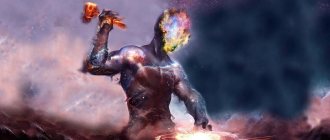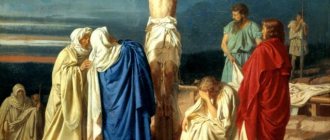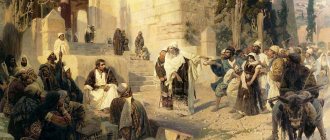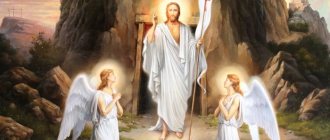"Save me, God!".
Thank you for visiting our website, before you start studying the information, please subscribe to our Orthodox community on Instagram, Lord, Save and Preserve † - https://www.instagram.com/spasi.gospodi/. The community has more than 60,000 subscribers. There are many of us like-minded people and we are growing quickly, we post prayers, sayings of saints, prayer requests, and timely post useful information about holidays and Orthodox events... Subscribe. Guardian Angel to you!
The story of the creation of the world in the Bible is known to almost every person, even those who do not particularly believe in the Lord. The depth of such knowledge lies solely in the power of faith and the study of the details of the sacred scriptures. Some of the information is passed on to us from generation to generation. For example, we all know that on the last day of the week it is necessary to drop everything and rest.
Creation of the world by the Lord
There is no indication of the exact year of the creation of the world according to the Bible, but there are references to the fact that the first man was created 7509 years ago. Since this book indicates that the creation of the planet took place at the same time, we can assume that the dates are very close. When reading this story, we learn that all the miracles of the Lord were divided into several days:
- In the first, He created light and separated it from darkness.
- On the second day He made the firmament and called it heaven. I placed it between the water that was on the ground and above it.
- It took Him the third day to open the seas, oceans, other waters, as well as continents. Even then, He made the entire plant world in order to somehow lay the foundation for the organic world on the surface.
- On the fourth, two celestial bodies were produced, which became known as the sun and the moon. After them the stars appeared.
- He spent the fifth day creating birds, fish and reptiles. but I did all the rest the next day.
- The sixth day was also marked by the birth of the first people. The man was made in the likeness of God from the dust of the earth, but the woman was made from the rib of a man, in order to obey him and submit in everything. He settled them in the Garden of Eden, from where they were eventually expelled for disobedience.
- On the last day, the Almighty decided to simply rest and contemplate what had happened to Him.
The best article for you, go to: New Testament of Kassian Bezobrazov
This is a brief description of the 7 days of the creation of the world in the Bible that everyone can find.
Orthodox Life
What kind of light does God create on the first day of creation? What is meant by the firmament of the second day of creation? How to explain to critics of the Bible why plants were created by the Lord before the Sun? What was the image of God in created man and what was the likeness? Religious historian Andrei Ivanovich Solodkov tells the story.
Mosaic of the Cathedral in honor of the Nativity of the Blessed Virgin Mary in Monreale (Duomo di Monreale)
Difference in time
Hello, dear readers and viewers of the Internet portal “Pravoslavie.Ru”. We continue our lectures and conversations about the Book of Genesis. Last time we talked about whether science has renounced God. We remembered that many prominent scientists: Isaac Newton, Mikhail Lomonosov, Albert Einstein and others believed in God as the Creator and Provider of this world. I would like to add a few more words to what was said at the last conversation.
The main postulate that reinforces the words that “science has proven that there is no God” is the following: our Earth is billions and billions of years old, and as a result of evolution, man and all of nature are moving along the path of progress, becoming better and more perfect. But is our Earth really billions of years old?
Creation scientists who do not identify themselves with any religion, chemists and physicists, doctors of exact sciences, say that, according to their research and calculations, our Earth is a maximum of 30 thousand years old; others, however, say that maybe only 20 thousand. And some are even inclined to believe that no more than 10 thousand. And according to Divine Revelation, transmitted in the Holy Scriptures, now the year 7524 has passed since the creation of the world. In our churches, by the way, on the antimensions it is written in what year this antimins was issued to the church, and two dates are indicated: from the creation of the world and from the Nativity of Christ.
So, scientists say that our Earth is young. And if this is so, if the Earth is young, then the whole theory of evolution collapses like a house of cards. What facts do scientists cite who believe that the Earth is 10–30 thousand years old?
In particular, these. Let's take a close look at the contours of the continents and islands indicated on the geographical map. Here is North America, here is South America, Eurasia, Australia, Japan, Africa... If we combine these contours, we will see that they form a single whole, they coincide quite well. It was once a single landmass, and then its parts separated from each other. But the movement of continents is determined by law. So, if our Earth is billions of years old - 45 billion, as evolutionists suggest (I am giving data from memory, I don’t remember the exact ones), then we should have observed some very serious catastrophes.
There is also other evidence. Let's take the distance of the Moon, this natural satellite of the Earth, from our planet. Scientists calculated the speed of the Moon’s distance from the Earth and on this basis concluded: our Earth is young; and if it were 45 billion years old, as evolutionists claim, then we should have lost the only satellite of the Earth. And another interesting fact: most of all at NASA, when launching its apparatus to the Moon, they were afraid that it would drown in cosmic dust - because they assumed that our Earth was more than tens of billions of years old. The Americans even made special umbrellas for their device so that it would not drown in cosmic dust. But when the spacecraft landed on the Moon, it turned out that the layer of dust on the Moon was only 3–4 cm. This, again, suggests that our Universe, our Earth, is young.
The next evidence is magnesium deposits. The chemical element magnesium is deposited in a certain amount. If our Earth is billions of years old, then we should be observing quite serious layers of these magnesium deposits somewhere. However, there are none. Another proof is related to the law of precession. There is a law of loss of energy of the Earth, when the Earth slows down in its rotation by some percentage for more than 70 years, and if our Earth is 45 billion years old, then the rotation should be such that simply on Earth, probably, either everyone has flattened into some kind of flatbread, or, conversely, flew away. When students in some classrooms ask me where the dinosaurs went, I say: “According to the theory of evolution, they just spun around and flew out of the Earth because they were the heaviest,” but this is a joke, but we will talk seriously and in detail about this when we read the lines of Holy Scripture.
So, as we see, in fact, there is no evidence that our Earth is billions of years old - this is just a theory and nothing more. But there are a lot of different theories.
“And God saw that it was good”
Let us now turn to the study of the Holy Scriptures. The first book of Holy Scripture is called the Book of Genesis, but its title literally translates as “The Beginning.” A person who knows his beginning, who knows where he comes from, what the meaning of his life is and how it will all end... such a person is more holistic in his consciousness.
So, let's read the 1st chapter.
"In the beginning God created the heaven and the earth. The earth was formless and empty, and darkness was over the abyss, and the Spirit of God hovered over the waters. And God said: Let there be light. And there was light” (Genesis 1: 1–3).
So, the first lines of Holy Scripture say that “in the beginning God created the heavens and the earth.” Here the word “God” is used in translation. In the Holy Scriptures, God has many names: Adonai, Shadai, Elohim, El, Hosts, Yahweh... Why does God have so many names? – The fact is that His essence cannot be expressed in any one name. And God, under that name, appeared to one of the people of Israel, a people who at a certain historical stage were a chosen people, a people who believed in the One God - and he was surrounded by pagan peoples: Moabites, Ammonites and others... so, God appeared under by one name or another, depending on what kind of revelation this person was supposed to receive. If God appeared, for example, with the name Elohim, it means that people forgot that God is the Creator and the Merciful. If Adonai, then people forgot that God is Master and began to put more hope in the earthly prince, in the son of man, and it is said: “Cursed is everyone who trusts in the son of man” (cf. Jer. 17:5). If Sabaoth, then people have forgotten that God is their Glory, that it is necessary to give glory to Him, and it is said: “I will glorify the one who glorifies Me” (cf. 1 Samuel 2:30).
Already in the first lines of the Bible, a lot is revealed. “God created” - but the name of God in the original is... in the plural. If translated literally, this biblical verse will sound like this: “In the beginning he created the gods.” Why is it plural? Immediately, from the first pages of Holy Scripture, its text gives a direct indication of God the Trinity. We will find such a direct indication in the Book of Genesis, in verse 26, where it says how God creates man; We will also meet this indication in the 18th chapter of the Book of Genesis - this is the appearance of the Holy Trinity to Abraham.
So, in the beginning God created the heavens and the earth. Many holy fathers say that the word “heaven” here should be understood as the world of angels and archangels - God creates the invisible world. The Earth is the Earth that exists to this day.
It is said: “The earth was formless and empty, and darkness was upon the deep, and the Spirit of God hovered over the waters” - the word “rushed” can be translated in different ways, here it means that “the Spirit hovered” or “warmed” the waters with His warmth.
Further: “The Lord said: let there be light, and there was light.” What was this light? This is a very important question. Saint Basil the Great writes the following on this occasion: “The Creator of all things, having spoken:
“Let there be light” instantly put the grace of light into the world.” So the light that is spoken of in the Holy Scriptures is the grace that God has put into this world.
Vladimir Lossky, a theologian who made a certain quintessence for a better perception of the works of the Church Fathers by a person not familiar with the patristic tradition, writes this: “Light... is not so much physical vibrations, that is, not so much the light visible to us, but
“the light of reason,” that is, the beginning of order and harmony in the universe.” So this light is the “light of the mind.”
And we read with you further:
“And God saw the light that it was good, and God separated the light from the darkness. And God called the light day and the darkness night. And there was evening, and there was morning: one day” (Genesis 1: 4–5).
Many people wonder: what is darkness? All the Church Fathers say: darkness is the absence of light. Thus, St. John of Damascus writes: “Darkness is not any substance... It is the deprivation of light.” So an Orthodox person, unlike adherents of any other religious systems, does not believe in the theory of dualism, according to which both good and evil allegedly existed from the beginning. Evil does not exist from the start! We will talk about the reason for the origin of evil when we look at the 3rd chapter of the book of Genesis.
And then we read:
“And God said, Let there be a firmament in the midst of the waters, and let it separate water from water. And the Lord God created the firmament, and separated the water that was under the firmament from the water that was above the firmament, and it became so. And God called the firmament heaven. And there was evening, and there was morning: the second day” (Gen. 1: 6–8).
On the second day the Lord creates the firmament. Many people think that the firmament is the earth. This is not so: the firmament is that weightlessness in which the Lord will subsequently arrange and establish the stars, the Earth, the solar system, the rest of the planets, in general the entire universe that is only possible for the human eye to perceive.
Let me note: Orthodox people who read the Holy Scriptures never believed those false ideas that are so often attributed to them, that the Earth was flat, supported by a turtle, and the turtle swam on the sea... These are precisely pagan theories. And we knew from the Book of Genesis, written one and a half thousand years before the birth of Christ, that the world was arranged by God wonderfully and wisely.
And what are the waters that are spoken of in the verse: “And he separated the water that was above the firmament from the water that was under the firmament”? What kind of waters are above the firmament and what are they below the firmament? The waters under the firmament are, as the Church Fathers teach, the seas and all the water that exists on Earth. And the waters above the firmament are a great mystery. The fact is that the word “firmament” translates the Hebrew word “raka” - a kind of “emptiness”. Emptiness, weightlessness. And the water above the firmament is, as said, some kind of cosmic waters that persist until a certain time. The Monk Ephraim the Syrian writes the following about this: “These waters remain there as the dew of blessings and are reserved for the outpouring of the wrath” of God until the end of this world. Saint Basil the Great also wrote something similar - that these waters are preserved until a certain time.
We all remember from school physics lessons such a device that demonstrates how lightning is born, how thunder is born, and we know that in this case certain energies collide, an electric discharge occurs, and we see lightning. But in real life - and we have all observed this more than once - thunderclouds charged with energy do not always produce lightning and thunder when they collide. Black clouds are coming, you expect a thunderstorm, but there is no lightning, no thunder is heard. Recently, scientists working at space stations and observing the Earth's atmosphere from space have seen the following, and their instruments, their computers, their equipment have recorded this: before lightning flashes, some rays invisible to the human eye first strike the clouds, then a discharge occurs and lightning flashes, and a little later thunder roars. And if this radiation does not exist, then no matter how charged clouds collide, nothing will happen. This, by the way, is also an example of the fact that we still know practically nothing about nature. Just recently in one of the TV programs they said that they found a squid 10–15 meters long. Everyone thought that such people did not exist, but in fact they do. Many scientists today say that only 7% of the world's oceans have been studied. 7%! It's nothing.
But we read Genesis further:
“And God said: Let the waters that are under the sky be gathered into one place, and let the dry land appear, and it was so. And God called the dry land earth, and the collection of waters he called seas. And God saw that it was good” (Genesis 1:9–10).
What is this water that first covered the entire Earth? The Monk Ephraim the Syrian writes that the water that covered the entire Earth was not salty - it was fresh. It was fresh to irrigate the entire Earth. But later, when God separates the dry land from the water and collects the water into the seas, the water became salty - so that there would be no decay, as St. Ephraim explains to us. That is, at first water was necessary for the fertilization of the Earth, and then it became such that there was no damage on the Earth.
We read further:
“And God said, Let the earth produce green grass, grass yielding seed, and a fruitful tree, bearing fruit according to its kind, in which is its seed on the earth. And so it became. And the earth brought forth grass, grass yielding seed according to its kind, and a tree bearing fruit, in which is its seed. And God saw that it was good. And there was evening, and there was morning: the third day” (Genesis 1: 11–13).
On the third day of creation, the Lord creates plants. And how wisely plants were created by God! Here, for example, is an acorn. Who put so much information into it that an oak will grow from an acorn, and not a birch or a pine? Who, in modern language, “uploaded” so much information into a sunflower seed, like into some kind of “flash drive”, that a sunflower would grow out of it, and it would also spin its hat, rotating from west to east? Who put so much information into an ordinary grain of wheat that it will later become bread? Who did all this? The question is very serious. If we don’t load anything into a regular computer or some kind of information storage device, it will remain a piece of metal or plastic. Therefore, God is the Creator and Provider of the world, He arranges everything in this world very wonderfully, He creates this world, creates it with His Providence, His will.
So on the third day God created vegetation. But this vegetation is still lifeless for some time - a very short time: one day: there were no birds yet, there were no fish yet, there were no animals yet that would inhabit these forests, there was still no man himself - the crown of creation.
We read further:
“And God said: Let there be lights in the expanse of the heaven to separate the day from the night, and for signs, and for seasons, and days, and years; and let them be lamps in the firmament of the heaven to give light on the earth. And it was so” (Genesis 1: 14–15).
“Let them be lamps in the firmament of heaven” - let us remember that the firmament is weightlessness, we have already talked about this. In connection with these verses of the Book of Genesis, one more thing needs to be said. Many critics of the Holy Scriptures are ironic: “You should at least edit the Holy Scriptures!.. How is it so: first greenery is created, grass that sows seed, and then the sun. It's just the opposite! First there must be the sun, and then the plants - they cannot grow without photosynthesis! The days somehow don’t go that way in the Bible.” No, we answer, Divine Revelation does not need any editing. God is all wise. God first creates plants for the reason that, as St. Basil the Great writes about this, you do not become an idolater, do not begin to worship the sun and do not think that the sun is the cause of all life on earth. Therefore, God first puts His light, His divine energy, His grace into plants, into every seed that is sown, into every bush that grows, into every petal, into every tree, into every flower that subsequently grows on the earth. God does everything so wisely and thereby delivers us from idolatry.
Here is another reproach: “How can it be: there is no sun yet, but the days are being counted.” And St. Ephraim the Syrian, and St. Basil the Great, and St. John of Damascus explained it this way: for a time, so that the days changed, the light plunged into the primordial waters and thus, as it were, illuminated them. Then night fell throughout the Earth. And in the morning the light rose from the primeval waters.
Now about the luminaries, which, as it is said, “let there be great lights here in the firmament of heaven to shine on the earth.” The Monk John of Damascus writes on this occasion: the Creator put the primordial light into the luminaries; the light found itself in the luminaries, for the luminaries are not light itself, but containers of light. Very important note. And St. Basil the Great points out: then the very nature of light was produced (that light, which is spoken of at the very beginning of the Book of Genesis, in the 1st verse of Chapter 1), and now this solar body is being prepared so that it serves as a chariot for that primeval clear and immaterial light . Thus, the light that God created on the first day of creation, He then puts into the luminaries - the sun and others that reflect the light of the sun.
We read further about what else happened on this day of creation:
“And God created two great lights: the greater light to rule the day, and the lesser light to rule the night, and the stars; and God set them in the firmament of the heaven to give light on the earth, and to rule the day and the night, and to separate the light from the darkness. And God saw that it was good. And there was evening, and there was morning: the fourth day” (Gen. 1: 16–19).
And further:
“And God said, Let the water bring forth living things; and let the birds fly over the earth, across the firmament of heaven. And God created the great fish and every living creature that moves, which the waters brought forth, according to their kinds, and every winged bird according to its kind. And God saw that it was good. And God blessed them, saying: Be fruitful and multiply, and fill the waters of the seas, and let birds multiply on the earth. And there was evening, and there was morning: the fifth day” (Gen. 1:20–23).
The Lord produces fish and birds. And having carefully looked at the world around us, knowing that God created fish and birds on the same day, we will perceive this world differently. What is the miracle of God here? Birds and fish have a lot in common. Birds have feathers—and fish have “feathers.” There is even a fish called rudd. And the penguin? This is a bird that lives in water. There are flying fish. There is a fish that can spend a lot of time above the water, then it dives and lives in the water for some time.
We read further:
“And God said, Let the earth produce living creatures according to their kinds, cattle and creeping things and wild beasts of the earth after their kinds. And so it became. And God created the beasts of the earth according to their kinds, and the cattle according to their kinds, and every creeping thing that creeps on the earth according to their kinds. And God saw that it was good” (Genesis 1:24–25).
On the sixth day God creates animals. And then - a person.
We read about the creation of man:
“And God said, Let us make man in our image, after our likeness, and let them have dominion over the fish of the sea, and over the birds of the air, and over the cattle, and over all the earth, and over every creeping thing that creeps on the earth” (Genesis 1: 26).
The Lord creates both animals and humans in one day, but how differently He does it! He creates animals, saying: “let the earth produce living souls”; creates a person completely differently. Let us remember that, while analyzing the first verses of the 1st chapter of the Book of Genesis, where it was said that in the beginning God created heaven and earth, I drew your attention to the fact that there is a direct indication of the Holy Trinity: the name of God - Elohim - is used in plural, and if these words are translated literally, it will be like this: “In the beginning he created the gods.” And in verse 26, the Russian Synodal translation clearly reflects this: and God said not “I will create,” but “Let us create.” The entire Holy Trinity takes part in the creation of man: “Let us make man in our image, in our likeness.”
What was the image and what was the likeness in man? The image, as many Church Fathers interpret, is the gift that God gave to you and me: our immortal soul. There was a time when man did not exist, but now there will be no time when man does not exist. God has always been, and, according to the words of St. Gregory the Theologian, one cannot say that God once was or He will be - God is. But there was a time when there was no man. However, there will be no time when man will not exist, because God gave man an immortal soul - this is the image. What is the similarity? God gave man a free soul - not only immortal, but also free. The similarity was that man, with his free will, could develop in God and reach God as much as is possible for creation. As St. Macarius the Great writes, to reach God and become a god - like this, with a small letter, but always remembering that God is the Creator, and I am a creation. Always remembering that He is the potter, and man is the pot.
The Lord creates this world. He creates everything according to His divine wisdom and His divine plan. He creates the waters, the firmament, and on the firmament he establishes the Earth, the vast Universe; creates fish, birds, stars, animals and finally man. And when we survey this entire picture of the universe, we see how harmonious everything is, how amazing, how providential everything is in this world by God. But, willingly or unwillingly, we also ask ourselves this question: if this is really so, then where does evil come from in the world? Why do some people live poorly and others live richly? Why are some people born into famous families, while others are never known? Why do some people admire the power in this world, while others are forced to count pennies and live on mere pennies? Why are some children born healthy and others sick? If God is the Creator and Provider of the world, then He is responsible for this world, right? This question - why God allows evil in the world - is very important. And we will talk about this topic at the next meeting.
Andrey Ivanovich Solodkov
Pravoslavie.Ru
Creation History and Evolution
The description of this creation is described in the Book of Genesis. The statement of this fact is attributed to Moses. It is the first narrative that speaks about the creation of the world according to the Bible, day by day. This text occupies the first and second chapters of the book. The narration comes in the form of a description of the work week. A large number of us think that the last day is Sunday. But this is where many of us are mistaken. The text indicates Saturday as a day off.
Scientists note that the earth was initially unstructured and empty. It was covered in darkness and for life to appear on it, some more time had to pass.
But not all scientists were of the opinion that the creation of the world was the work of the Lord. Atheists who are quite skeptical about this issue. They compare the creation of the world according to the Bible and the theory of evolution and find great differences in them. A large number of studies have been conducted that tend to favor the view that life on earth appeared after some changes, but not God’s intervention.
The best article for you, go to: Protestants, how they differ from Orthodox Christians
They do not deny the possibility of something higher, but it is unlikely that it somehow influenced the development of life on earth. In the natural sciences, the origin of life on the planet had a slightly different development. It is in connection with great strides in the field of knowledge of the world that the discussion between these two warring camps has somewhat intensified.
Friction on this issue has been going on for decades and will continue for a long time. Scientists will defend their point of view, and believers will strongly affirm the hand of the Lord that he put into this matter.
How one feels about this fact is purely personal. But we should not forget that no matter what knowledge we have and no matter how far progress has gone, sometimes it is worth bowing before the greatness of the miracle of the Creator.
May the Lord protect you!
Biblical...evolution
Proponents of evolutionary theory base their hypotheses on geological data. According to them, in the most ancient layers of rocks, only the simplest are found, a little later - plants, then fish, lizards, even later - birds, then all of them, plus mammals, new species of reptiles. The person appears later than everyone else. On this basis, evolutionists say that one type of animal has “outgrown” or turned into another, that is, about evolution. This is just a theory that encounters many opponents in the secular scientific world. Facts are just what she relies on. And they correspond exactly to the book of Genesis.
Evolution means "development". The creation of the world, described in the Holy Scriptures, can indeed be represented as a kind of gradual development of life forms. God does not create each fish and bird separately. The text of the book of Genesis says: “let the water bring forth them” about fish, reptiles and... birds, and “let the earth bring forth living creatures” - about cattle (ungulates), reptiles and beasts. They all appear in two different eras of creation - the fifth and sixth. Plants are created much earlier: on the third day of creation. They, too, were “produced by the earth.”
Species evolve and become more numerous at the same time as fish, birds and mammals appear. Perhaps today, slowly and imperceptibly for us, this process of the emergence of new life forms also continues... Any biologist will tell you that the first animal life forms initially originated in water. However, none of them will be able to explain how they got there...
A separate issue is the death of living beings, the remains of which are found en masse by geologists in various rocks, in their opinion, long before the appearance of man. The Bible does not answer this question. For me personally, it remained unresolved. Should we not assume that geologists are mistaken and that our Earth is not 4.5 billion years old? Although in the “boring billion,” when, according to scientists, nothing happened at all, I might have doubts.
The process of formation by living organisms of organic molecules from inorganic ones using energy
The initial substances of photosynthesis - carbon dioxide and water on the earth's surface are neither oxidizing nor reducing agents. During photosynthesis, this “neutral environment” bifurcates into opposites: a strong oxidizing agent - free oxygen and strong reducing agents - organic compounds arise (outside plant organisms, the decomposition of carbon dioxide and water is possible only at high temperatures, for example, in magma or in blast furnaces, etc.). d.).
Carbon and hydrogen of organic compounds, as well as free oxygen released during photosynthesis, were “charged” with solar energy, rose to a higher energy level, and became “geochemical batteries”.
Carbohydrates and other products of photosynthesis, moving from leaves to stems and roots, enter into complex reactions, during which a whole variety of organic compounds of plants are created.
However, plants are composed not only of carbon, hydrogen and oxygen, but also of nitrogen, phosphorus, potassium, calcium, iron and other chemical elements, which they receive in the form of relatively simple mineral compounds from soil or water bodies.
Absorbed by plants, these elements become part of complex energy-rich organic compounds (nitrogen and sulfur - into proteins, phosphorus - into nucleoproteins, etc.) and also become geochemical batteries.
This process is called biogenic accumulation of mineral compounds. Thanks to biogenic accumulation, elements from water and air pass into a less mobile state, i.e. their migration ability decreases. All other organisms are animals, the vast majority of microorganisms and chlorophyll-free plants (for example, fungi) are heterotrophs, i.e. they are not capable of creating organic substances from mineral ones.
They obtain organic compounds needed to build their bodies and as a source of energy from green plants.
The process of photosynthesis occurs in unity with the work of the root system, which supplies water and nutrients to the leaf.
There are a number of hypotheses explaining the mechanism of ion entry through the root system: by diffusion, adsorption, metabolic transfer of substances against an electrochemical gradient. All hypotheses are based on the statement about the exchange of ions between the root system and the soil. At the same time, the root system, like the leaf, is a laboratory of synthesis. Plants, through the root system, primarily absorb those chemical elements that perform necessary functions in the body.
Other elements penetrate mechanically in accordance with their concentration gradient. Simultaneously with the release of nutritional elements, various metabolic products are released into the soil by the root system. Among them, organic acids (citric, malic, oxalic, etc.) perform an important function.
As a result of dissociation, hydrogen ions are released, which acidify the soil reaction, thereby accelerating the dissolution of minerals and releasing chemical elements for plant nutrition.
Other metabolic products are used in the vital activity of certain types of microorganisms, which are also involved in the destruction of minerals.
Cations and anions that enter plants through the root system are distributed in organs and tissues, are included in organic and mineral compounds, perform various physiological functions: maintain osmotic pressure, alkaline-acid balance, are used as a plastic material, a component of enzymes, chlorophyll and etc. During the metabolic process, there is a continuous formation of acidic compounds.
The breakdown of carbohydrates produces pyruvic and lactic acids, the breakdown of fatty acids produces butyric and acetoacetic acids, and the breakdown of proteins produces sulfuric and phosphoric acids. Excessive accumulation of acids is neutralized by buffer compounds, which convert them into compounds that are easily removed from the body.
The synthesis of organic matter occurs not only through the use of radiant energy from the sun by green plants.
Bacteria are known that use for this purpose the energy released during the oxidation of certain inorganic compounds (In 1890.
S.P. Vinogradsky discovered microorganisms capable of oxidizing ammonia to nitrous salts and then nitric acids). This process of creating organic substances is called chemosynthesis. Chemosynthetic bacteria are typical autotrophs, i.e. They independently synthesize the necessary organic compounds (carbohydrates, proteins, lipids, etc.) from inorganic substances. The most important group of chemosynthetic microorganisms are nitrifying bacteria.
They oxidize ammonia, formed during the decay of organic residues, to nitric acid. Chemosynthetic bacteria include sulfur-, iron-, methane-, carbon bacteria, etc. For example, in the soils of floodplains, bog iron ore is often found in the form of durable nodules of various shapes and sizes; it is formed with the participation of iron bacteria.
Under the influence of iron bacteria, ferrous iron is converted into oxide iron. The resulting iron hydroxide precipitates and forms bog iron ore.
Where did the dinosaurs go?
Twice within just a few adjacent lines of Genesis the creation of reptiles is mentioned. Each time a different word is used for them. The first time it is šereç from a word meaning “to move.” A word still used in modern Hebrew for reptiles, which apparently originated as an onomatopoeia for the sound they make when they hiss or crawl. These sheretz are produced by water. In the book of Genesis, their creation is described by a verse that is striking in sound, the beauty of which is lost in translation: “jišreśu hammajim šereç nefeš hajja” (“yishretsu hamayim sherets nefesh haya”). It perfectly conveys the infestation of reptiles or insects. By the way, nothing is said about the creation of the latter. Or it’s... Sherets.
The second time these are really “reptiles” - remes from ramas “to creep, crawl”, which the earth produces. In addition to reptiles themselves, biologists also know amphibians and ancient extinct reptiles - dinosaurs, which, they believe, gave rise not only to modern reptiles, but also to birds and mammals. All of them are also suitable for the role of the second reptiles mentioned.
Let's fast forward to the creation of man. The Lord subordinates the previously created animals to the newly created being, listing them: And have dominion over the fish of the sea and over the birds of the air, and over every living thing that moves on the earth (Gen. 1:28). “Cattle and beasts” are not mentioned here, and of the two species of reptiles, only remes are indicated...
Let's now see what animals Noah brings into his ark. “Bring also into the ark two of every living creature, and of every flesh, so that they may remain alive with you; let them be male and female. Of the birds according to their kinds, and of the livestock according to their kinds, and of every creeping thing that creeps on the earth according to its kind, two of every kind will come to you, so that you may live” (Genesis 5:19-20). In the original there are also remes.
Unfortunately, the Bible does not reveal to us the secrets of dinosaurs, nor does it answer the question of whether there are aliens or any forms of life on other planets. This is understandable: after all, it is primarily devoted to spiritual issues. This is a book about the history of the relationship between man and God, and not about dinosaurs... Or perhaps there is simply nothing to discover there: after all, the mysterious and amazing monsters leviathan and hippopotamus in the books of Job and Isaiah, the mysterious dragon in the book of the prophet Daniel are mentioned simply as one of the animals. And in general, are you 100% sure that they are extinct?









